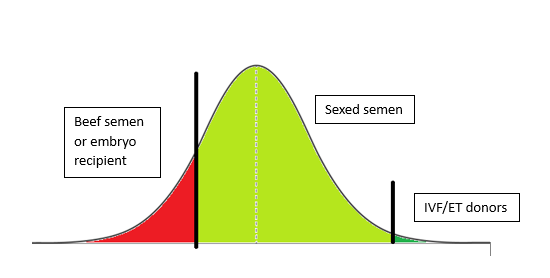In the first article of this series, we looked at what tools are now available to assist with advancing the genetics of the dairy herd, from genetic data to IVF. In this follow on article we will now look at how to make the most of those tools on farm.
Genetic data
Clearly, we need to be making the most of genetic data where it is available. Parent average £PLI values are available online for any purebred and milk recorded dairy herd in the UK via the AHDB herd genetic report. Using this to rank animals and base selection decisions on genetic potential is a fundamental step in maximising genetic progress. We will go into the nuts and bolts of selection decisions in a later article, but essentially the more accurate we are at predicting genetic potential the quicker we can make genetic progress. For traits such as fertility, feed efficiency and health, the appearance of an animal has very little correlation to their genetic potential. So whilst type classification may still have a place for some traits (eg. Udder characteristics) I would argue quite strongly that it has now been superseded by the huge database of predicted transmitting ability (PTA) values we have access to for many of the commercial dairy breeds. The reliabilities of these PTAs vary hugely between traits and animals depending on the amount and quality of the dataset but they are significantly better predictors of genetic merit than any other measure.
Genomic testing
On eligible purebred herds where there is no cross breeding in the last few generations, genomic figures are the best way to get highly accurate genetic figures on young animals, allowing us to better sort the most profitable future cows from the ones most likely to cost the farm money. The range of traits available is now staggering, with almost 100 different traits and conditions included in some of the more comprehensive evaluations. By giving us high reliability index values genomics allows us to better rank animals and make better decisions as to the future of each animal. The more decisions we can make off the back of the results, the more progress can be made and the more we will benefit financially in the long run.
When choosing a genomic test provider, it’s important to find out how easy it will be to do the testing, how accessible the results are, and which evaluations are included for the price. All too often there is insufficient support provided to help with both the testing and interpretation, which then gets forgotten about in the busy day to day running of the farm. All heifers in a cohort should be tested and it is important to do them well ahead of mating so there is sufficient time to get results back and a mating plan created. For that reason, I recommend getting heifers tested by 11 months at the latest. If heifers are sampled at an early age, then decisions can be made earlier and heifers with very low figures could be sold if there is sufficient surplus and the herd is not under TB restriction.
Genetic traits and indexes
Whilst it’s useful to have an idea of the traits that are available and how they work, we often don’t have the time or headspace to get lost in the detail, so I generally recommend picking an index that suits your system/breeding goals and trusting it to do the work of juggling individual trait importance for you. It’s impossible to compare a bunch of heifers looking at more than 2 traits and sort them into a ranked list without an index. Some companies do offer bespoke indexes, which may seem tempting, however we are unlikely to know how the bespoke index will affect all the other traits of significance. For example, increasing the emphasis on fertility will have a negative effect on yields and possibly other traits as well. Published indexes have been constructed by industry professionals testing hundreds of iterations against profitability estimates. I suspect making up our own indexes with numbers plucked out of the air is unlikely to improve selection of profitable animals!
Sexed semen and Advanced breeding
The most progressive and successful dairies in the UK have long switched to sexed and beef only strategies. With sexed semen now available on almost all bulls as standard and with conception rates comparable to conventional semen it really is a no brainer to be moving away from conventional semen altogether. Genetically the massive advantage is that we can increase selection pressure by only putting dairy semen into our best animals.
When ranking any population of animals, we will likely see a “bell shaped curve” of genetic merit, with most animals clustered around the average and then spreading out to only a few animals at the extremes. To really maximise genetic progress, we need to make the most of these differences and one way to do that is by multiplying up the outliers on the far right as much as possible whilst not retaining the genetics of the animals on the left. A typical strategy for maiden heifers might look like this:

If you would like to find out more about anything discussed here, or for support improving your herd’s genetic selection, please give us a call at the practice on 01453511311.